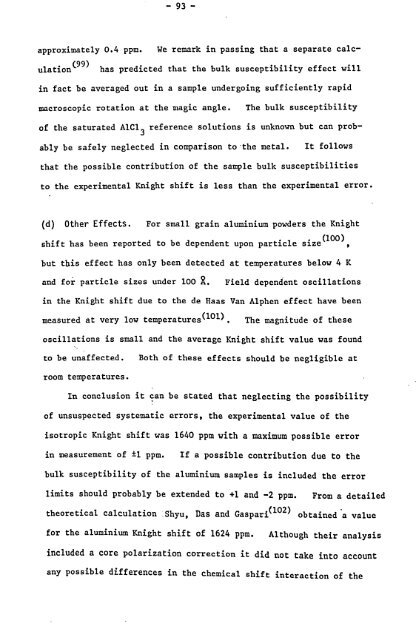NNR IN RAPIDLY ROTATED METALS By - Nottingham eTheses ...
NNR IN RAPIDLY ROTATED METALS By - Nottingham eTheses ...
NNR IN RAPIDLY ROTATED METALS By - Nottingham eTheses ...
You also want an ePaper? Increase the reach of your titles
YUMPU automatically turns print PDFs into web optimized ePapers that Google loves.
- 93 -<br />
approximately 0.4 ppm. We remark in passing that a separate calc-<br />
ulation(99) has predicted that the bulk susceptibility effect will<br />
in fact be averaged out in a sample undergoing sufficiently rapid<br />
macroscopic rotation at the magic angle. The bulk susceptibility<br />
of the saturated Aid 3 reference solutions is unknown but can prob-<br />
ably be safely neglected in comparison to-the metal. It follows<br />
that the possible contribution of the sample bulk susceptibilities<br />
to the experimental Knight shift is less than the experimental error.<br />
(d) Other Effects. For small grain aluminium powders the Knight<br />
shift has been reported to be dependent upon particle size(100)9<br />
but this effect has only been detected at temperatures below 4K<br />
and for particle sizes under 100 Field dependent oscillations<br />
in the Knight shift due to the de Haas Van Alphen effect have been<br />
measured at very low temperatures(101). The magnitude of these<br />
oscillations is small and the average Knight shift value was found<br />
to be unaffected. Both of these effects should be negligible at<br />
room temperatures.<br />
In conclusion it can be stated that neglecting the possibility<br />
of unsuspected systematic errors, the experimental value of the<br />
isotropic Knight shift was 1640 ppm with a maximum possible error<br />
in measurement of ±1 ppm. If a possible contribution due to the<br />
bulk susceptibility of the aluminium samples is included the error<br />
limits should probably be extended to +1 and -2 ppm. From a detailed<br />
theoretical calculation . Shyu, Das and Gaspari(102) obtained<br />
'a value<br />
for the aluminium Knight shift of 1624 ppm. Although their analysis<br />
included a core polarization correction it did not take into account<br />
any possible differences in the chemical shift interaction<br />
of the

















